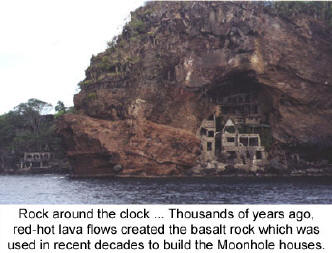The Moonhole Lava Flows in the Grenadines

By Susan Vansant Bartz,
a geologist who sailed with us in 2001. Susie was fascinated by the Moonhole
community and
published the following article in the Caribbean Compass, November 2001.
The spectacular rock dwellings at the Moonhole are a real visual treat for boaters approaching Bequia’s
Admiralty Bay. Emerging from the cliffs along the western peninsula, these
buildings are made of the same black volcanic rock, called basalt, that
surrounds them. If there ever was a marriage of dwelling to landscape, this is
it.
The original home, built by Tom Johnston under a natural arch, was abandoned
when a huge boulder fell onto it from the rocks above. The surrounding cliffs
may provide a clue to the demise of the original structure. But first it’s
helpful to understand the rocks in their larger tectonic context.
The Tectonic Story: a Volcanic Arc
Bequia is part of a chain of volcanic islands at the edge of a piece of the earth’s crust called the Caribbean Tectonic Plate. For the past 50 million years, this plate has ground against another plate to the east, causing the crust to melt near the edges. As a result, a line of volcanoes has erupted there. The big ones emerged from the ocean in a volcanic arc, which we know as the Lesser Antilles Islands. Volcanic activity continues today, for example at the steamy caldera near Soufrière on the island of St. Lucia. The rocks around the Moonhole reflect Bequia’s part in this dynamic story.
Crystal in the Rocks
Next time you visit the Moonhole, take a close look at the masonry on the
walls and stairways. You’ll probably notice that some of those dark basalt rocks
are full of tiny specks. These are actually clusters of pretty green, glassy
crystals which are a mineral called olivine. You can see them quite easily with
a 10-power hand lens. In gem form, olivine is known as peridot.
The geological name for basalt rocks with the visible crystals is olivine basalt
porphyry. The name porphyry tells us that those particular rocks cooled in two
stages from their molten state. In the earliest stage, while the melt was still
deep under the earth’s surface and cooling slowly, the olivine ingredient
reached a temperature where it changed to solid crystals. And enough time passed
— maybe thousands of years — for the crystals to grow big enough to see.
In the second stage, the rest of the melt finally erupted at the surface, where
it cooled quickly into solid basalt. There are other minerals in basalt,
including white plagioclase and black pyroxene. These minerals need cooler
temperatures to form crystals. But they cooled so quickly that their crystals
didn’t have a chance to grow large enough to see, even with a hand lens. What we
see, then, are the beautiful green olivine crystals floating around in a matrix,
or ground-mass, of dark grayish rock.
Geological History in the Cliff
Like its neighbors, Bequia’s land was built from layer upon layer of hot lava
flows over many, many years. Seen from the water, the Moonhole cliffs give you a
cutaway view of several of these flows. They’re a piece of geological history,
right in front of you!
The brownish-gray layers that look dark and solid are made of hard basalt rock.
It cooled from red-hot lava that poured from an erupting volcano. Other layers
look lighter, less solid, and are full of stones and boulders. These are called
volcanic debris-flows. They formed when the hot lava picked up loose mud and
stones and tumbled them along a slug of muddy debris.
Some flows are separated by a thin, rust-colored layer called a clay horizon. It
formed across time between eruptions, as rain slowly changed the surface rock
into a clay soil. This process is called weathering. The clay horizon is a rusty
color because basalt is rich in iron. And wet iron rusts!
Some of the clay horizons are undercut in the cliff face, because clay erodes
away more easily than the rock layers above and below it. Since the clay
horizons separate distinct flows, they can show you the number of volcanic
events recorded in the cliff.
Eroding Rock and Falling Boulders
One reason for the presence of the arch at Moonhole, as well as the collapse
of rock onto the dwelling below, is the erosion of the less solid material
there. The waves have also done their part in eating away the rock from below.
Look carefully at the roof of this arch. Although one side has the dark look of
solid basalt, the other side appears to be a debris-flow. The lighter yellowish
stains between them indicate major cracks in the arch, where rainwater is
eroding the rock and leaching out the cement that holds it together.
Essentially, the debris-flow is very slowly eroding and breaking apart. From a
geologists point of view, then, it’s no surprise that a boulder eventually broke
loose and fell onto the roof below.
Fortunately for the Johnston family and other Moonhole residents, the rest of
the dwellings are built onto the tops or sides of the volcanic flows, not under
them. So we can expect to enjoy those unique architectural wonders for many, many years to come.


